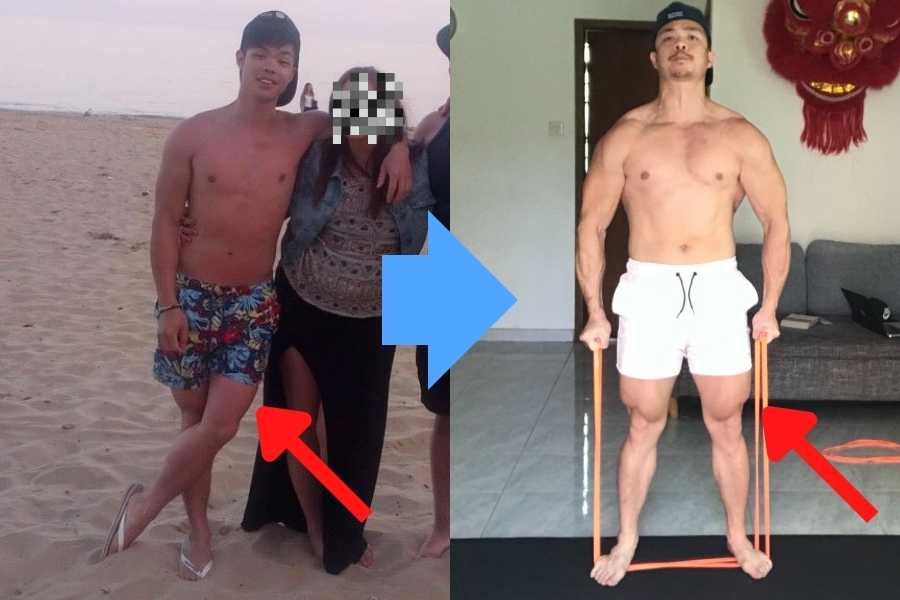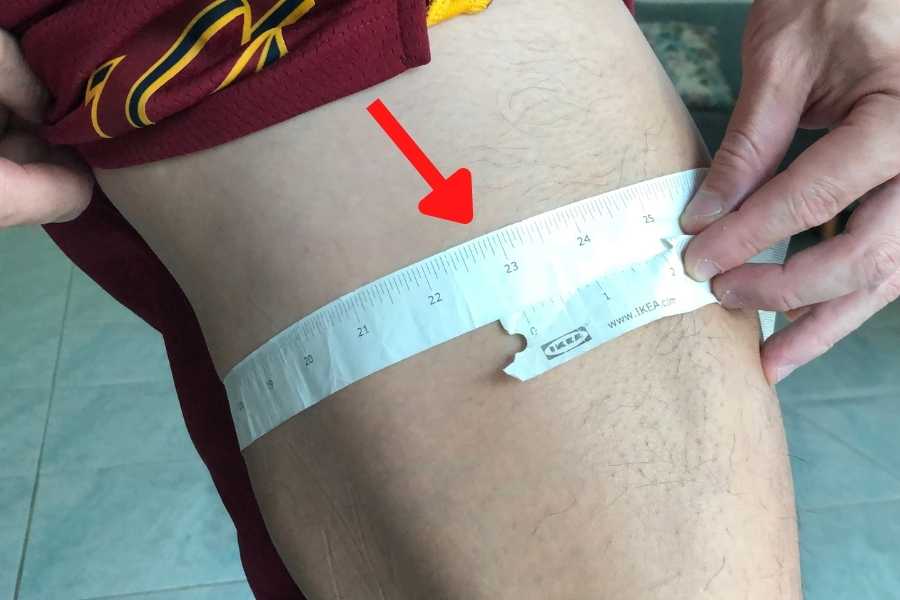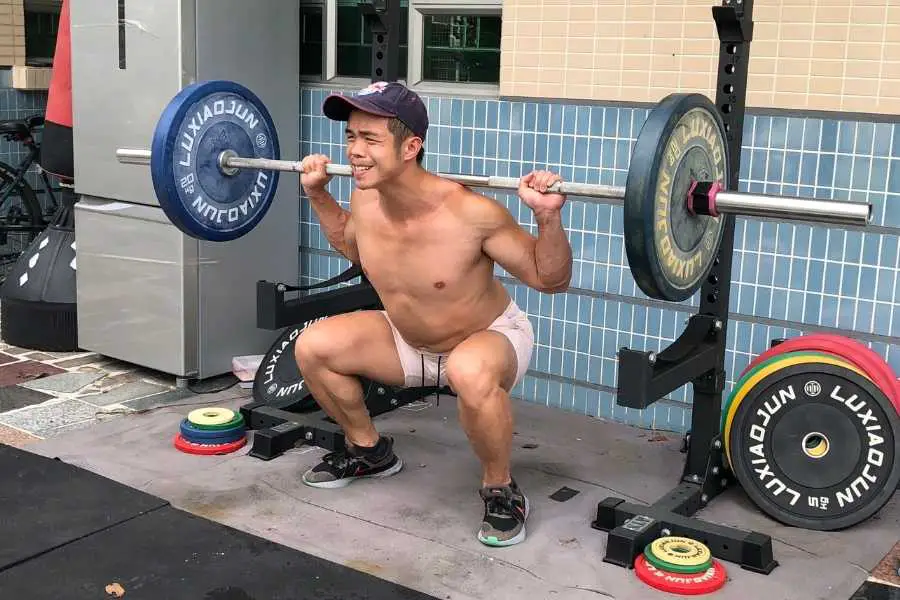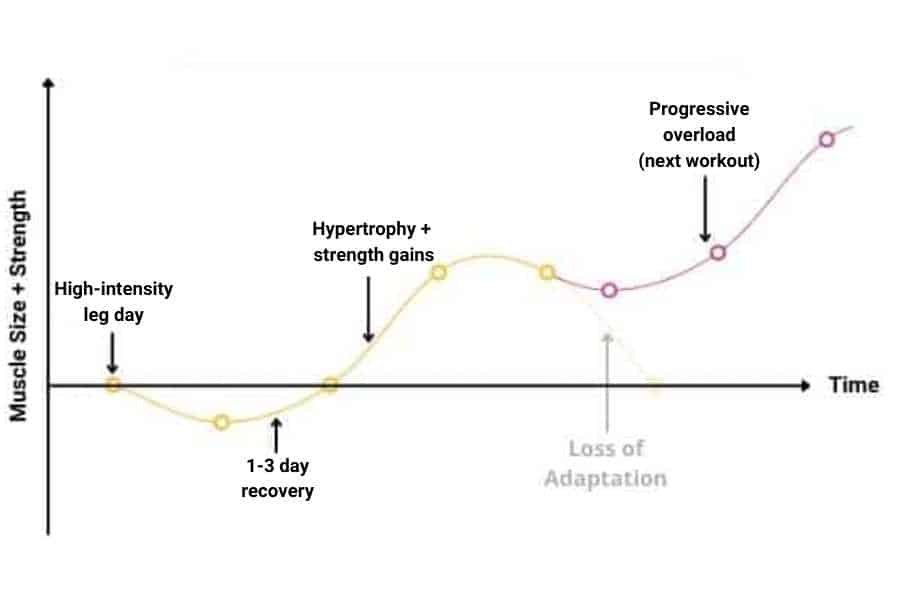The legs are one of the most popular muscle groups to train. However, many people work out far too much in an effort to build a shapely lower body. This post explains why working your legs every day is generally bad and instances when it can be good.
It is not recommended to train legs daily with high-intensity workouts. This can increase the risk of overtraining and does not confer significant hypertrophy and strength benefits, compared to a 2 or 3-day split. In contrast, it is fine to train the legs daily with light-intensity workouts.
Below, I discuss what counts as a “high-” and “low-” intensity workout, why too many high-intensity workouts per week are not ideal, and why daily light-intensity workouts are ok.

- Definition Of High- And Low-Intensity Leg Training
- Case Study: Negative Effects Of Doing Heavy Leg Workouts Every Day
- Why High-Intensity Leg Workouts Every Day Are Bad
- How Daily Heavy Leg Workouts Leads To Overtraining
- Why Daily Low-Intensity Leg Workouts Are Acceptable
- Is Low- Or High-Intensity Workouts Better For The Legs?
- Conclusion
Definition Of High- And Low-Intensity Leg Training
The intensity of your leg training (whether it be cardio or weightlifting) has a big influence on whether or not working your legs every day is productive or counter-productive.
Here are the main differences between a high- and low-intensity workout:
| Training Intensity | Cardio | Weights | Ok To Train Every Day? |
|---|---|---|---|
| High | Sustaining >75% of your max heart rate for >10 mins | Lifting >60% of your 1RM for >3 sets | No |
| Low | Sustaining <75% of your max heart rate for <10 mins | Lifting <70% of your 1RM for <3 sets | Yes |
Examples of high-intensity leg workouts include:
- Heavy barbell, dumbbell, and machine exercises performed at >60% of your 1RM for >3 sets per workout (examples include squats, deadlifts, leg extensions, and ham curls).
- Running or cycling at a speed that increases your heart rate to >75% of its max for >10 mins per workout.
- Bodyweight squats performed close to muscular failure for more than 3 sets per workout.
Examples of low-intensity leg workouts include:
- Jogging at a speed under 5mph (8kph) for less than 2.5 hours a week.
- Cycling at a spend under 10mph (16kph) for less than 2.5 hours a week.
- Bodyweight squats performed to less than 3 sets per workout and less than 15 sets per week.
Definitions:
- Estimated max heart rate = 220 minus [your age]. For example, the max heart rate for a 30-year-old would be ~190BPM (beats per minute). And 75% of 190BPM is 143BPM.
- 1RM = 1 rep max. This is the maximum weight you can lift for a single rep on a given exercise. You can use a 1RM database to find your estimates. For example, 60% of a 150lbs barbell squat is 90lbs.
Case Study: Negative Effects Of Doing Heavy Leg Workouts Every Day
Bodybuilder Troy Adashun performed an experiment where he undertook a heavy legs program for 1 year. Furthermore, he did legs every day for 30 days straight for 1 out of the 12 months. During this period, his lower body took a battering from heavy squats and regular progressive overload. For the remaining 11 months, he did legs twice a week.
Skip to 7.00 for the results of the study.
You can see the results of Troy’s experiment summarized in the table below. I’ve also included data from my own legs transformation case study for further comparison. For reference, I was an intermediate lifter at the time of the study.
Here are the results:
| 7 Heavy Leg Days Per Week | 2 Heavy Leg Days Per Week | 3 Heavy Leg Days Per Week | |
|---|---|---|---|
| Study Participant: | Troy | Troy | Me |
| Study Duration: | 1 month | 12 months | 18 months |
| Thigh Circumference (Before): | 22 inches | 22 inches | 19 inches |
| Thigh Circumference (After): | 22.25 inches | 25 inches | 23 inches |
| Total Circumference Gained: | 0.25 inches | 3 inches | 4 inches |
| Thigh Circumference Gain Rate: | 0.25 inches per month* | 0.25 inches per month* | 0.22 inches per month* |
Troy saw insignificant hypertrophy benefits when training his legs every day, compared to following a 2-day leg split. This was despite all the extra workload that came with the former category. Troy states that he felt drained and fatigued throughout his daily leg program.
Furthermore, both categories led to a thigh circumference gain rate of 0.25 inches per month. Additionally, I followed a 3-day heavy leg split for 18 months and still gained 0.22 inches per month.
Now you can see why it’s not recommended to train your legs every day:
Why waste time and effort when you get similar results by working your legs 2-3 times per week?

Interestingly, Troy saw a significant increase in strength gains and improved recovery (but not in leg size). However, you should bear in mind that he is a trained bodybuilder. The average beginner-intermediate lifter would likely not respond in the same manner.
Take-home message- your legs have limited growth potential and training them with daily high-intensity workouts does not confer added hypertrophy (size gain) benefits compared to following a traditional 2 or 3-day split (although strength and recovery may improve in trained lifters). Daily high-intensity workouts are also mentally and physically fatiguing. Ultimately, Troy does not recommend hitting your legs hard every day.
If you’re interested, you can check out the barbell workout I used to train my legs as part of a full-body program.
Why High-Intensity Leg Workouts Every Day Are Bad
Daily high-intensity leg workouts generally lead to overtraining. Signs of this include excessive muscle soreness, delayed recovery, reduced muscular performance, and plateaued muscle growth.

It’s for this reason that heavy leg days are generally performed as part of a workout split. In other words, most people (including professional bodybuilders and powerlifters) do not train their legs every day.
Rather, they spend 2-3 days (sometimes 4) focusing on the lower body. This allows them to reach the required training volume for quad/hamstring/glute/calf hypertrophy, as well as rest for the recommended 24-48 hours for optimal muscle recovery and growth.
Take-home message- high-intensity leg workouts have many benefits for a bigger and stronger lower body. But going heavy every day can lead to overtraining, is extremely fatiguing, and does not confer added hypertrophy benefits.
How Daily Heavy Leg Workouts Leads To Overtraining
Understanding what happens to your muscles during high-intensity sessions will help you to realize why heavy leg workouts every day can lead to the negative effects described above. Here’s the simplified process:
- Small micro-tears form in the quads, hamstrings, glutes, and calves during the workout. This leads to reduced muscle performance.
- Cellular repair initiates in the muscle fibers which can take from 24-72 hours to complete. This is why your legs feel sore and weak after intense training and why it can take a few days to fully recover.
- Applying progressive overload (increasing exercise intensity) after the completion of the recovery period leads to muscle hypertrophy and strength gains.
- Repeated damage-repair cycles drive continued muscle hypertrophy and strength gains (assuming a sufficient intensity is applied)
This can be represented by the Strength-Recovery-Adaptation (SRA) model below.

You can see that it’s only after the leg muscle recovers to baseline, does it begin to adapt and grow. You interfere with the recovery process if you go heavy every day. Consequently, your legs will not get bigger or stronger.
The better alternative is to hit the lower body hard and rest for 1-3 days before going again. This is a much more efficient use of your time. If you’re interested in learning more, you can check out my other post on the ideal training frequency for beginners.
Why Daily Low-Intensity Leg Workouts Are Acceptable
In contrast to high-intensity workouts, it’s generally ok to do light leg training every day. The muscles in your legs are some of the biggest and strongest in the whole body. As such, they can handle a light workload daily and still recover in time for the next workout.

However, it’s essential to not “overdo” things by exceeding the quota recommended at the start of this post (see section “Definition Of High- And Low-Intensity Leg Training”). The last thing you want is to inadvertently turn your low-intensity workout into a high-intensity blitz.
Speaking from experience, this can be easy to do (especially if you’re enjoying your training). Make sure you’re “light leg workouts” are actually performed at a low intensity and you can safely train every day with minimal consequences.
If you find your legs feeling extremely sore, or soreness is leading to reduced performance, then this is a big sign to dial down the intensity.
Is Low- Or High-Intensity Workouts Better For The Legs?
High-intensity workouts are better suited for muscle growth and strength gains. In contrast, low-intensity workouts are ideal for general health, muscular endurance, and cardiovascular fitness. Both types of training have unique benefits for different training goals.
| High-Intensity Benefits | Low-Intensity Benefits |
|---|---|
| Muscle hypertrophy (growth) | Improved muscular endurance |
| Increased strength and power | Increased cardiovascular fitness |
| Fat loss (with a controlled diet) | Fat loss (with a controlled diet) |
| Muscle toning | Better general health and fitness |
For beginner-intermediate lifters (1-24 months of training experience) looking to increase leg size and strength:
- Perform high-intensity workouts 2-3 days a week. Intermediates can increase to 4 days a week.
- Heavy squats, deadlifts, and quad/hamstring/glute/calf-isolation machine exercises are ideal.
- Ensure at least 24 hours of rest before the legs are worked again.
For beginner lifters looking to improve general health and fitness.
- Perform low-intensity workouts up to 7 days a week. I prefer doing moderate to high-intensity workouts up to 4 days a week instead to save time.
- Bodyweight squats, light running, cycling, and band exercises are ideal.
- 24 hours of rest is not essential if the intensity is kept low. But listen to your body- your muscles shouldn’t feel so sore that it’s painful for the next workout.
You can check out my other article if you’re interested in the timeframe for getting bigger muscles.
Conclusion
As my case study shows, working your legs every day with high-intensity sessions is generally bad. You waste time and go through excessive fatigue without added hypertrophy benefits. The risk of overtraining also increases.
It is much more efficient to hit your lower body hard in a 2- or 3-day split instead.
However, the legs can be trained daily if you maintain a low intensity. This can be great for beginners looking to improve general health and fitness.
You may also be interested in the downloadable Kalibre Blueprint PDF which details exactly how I gained 40lbs of lean muscle (it’s 100% free!). It details the exact exercises and nutrition (with printables) I used to go from skinny to ripped!


